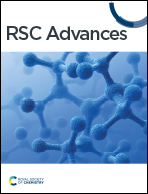A fluorous-tag-assisted fluorescent probe for simple and selective detection of hydrogen sulfide: application for turbid dyeing solutions†
Abstract
Accurate hydrogen sulfide (H2S) detection has attracted much attention because its toxicity may affect aquatic environments and human health. However, recognizing H2S levels by conventional fluorescent probes in turbid wastewater has been challenging because the opaque environment interferes with their photophysical properties. To overcome this limitation, a fluorous-tagging strategy can be used for the development of fluorescent sensors to detect H2S in turbid solutions. The use of fluorescent probe assisted with fluorous-tag allowed for easy isolation of the probe using polytetrafluoroethylene (PTFE) material, while disturbing species were eliminated through a simple aqueous wash. This approach enabled the fluorescent probe to effectively quantify H2S, even in opaque solutions containing organic dyes that could interfere with fluorescence emission.



 Please wait while we load your content...
Please wait while we load your content...